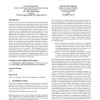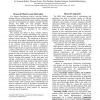36 search results - page 7 / 8 » Coordination of multiple non-holonomic agents with input con... |
AAAI
2010
13 years 7 months ago
2010
Multi-Agent Plan Recognition (MAPR) seeks to identify the dynamic team structures and team behaviors from the observations of the activity-sequences of a set of intelligent agents...
ATAL
2010
Springer
13 years 7 months ago
2010
Springer
Social laws have proved to be a powerful and theoretically elegant framework for coordination in multi-agent systems. Most existing models of social laws assume that a designer is...
ICWL
2005
Springer
13 years 11 months ago
2005
Springer
In this paper we investigate the use of Latent Semantic Analysis (LSA), Critiquing Systems, and Knowledge Building to support computerbased teaching of English composition. We have...
AAAI
2000
13 years 7 months ago
2000
or cone, abstraction is chosen to represent a spectrum of user inputs/requirements that are narrowed, refined, and structured into a system design. User inputs require refinement f...
IJCAI
2001
13 years 7 months ago
2001
In the future, webs of unmanned air and space vehicles will act together to robustly perform elaborate missions in uncertain environments. We coordinate these systems by introduci...


